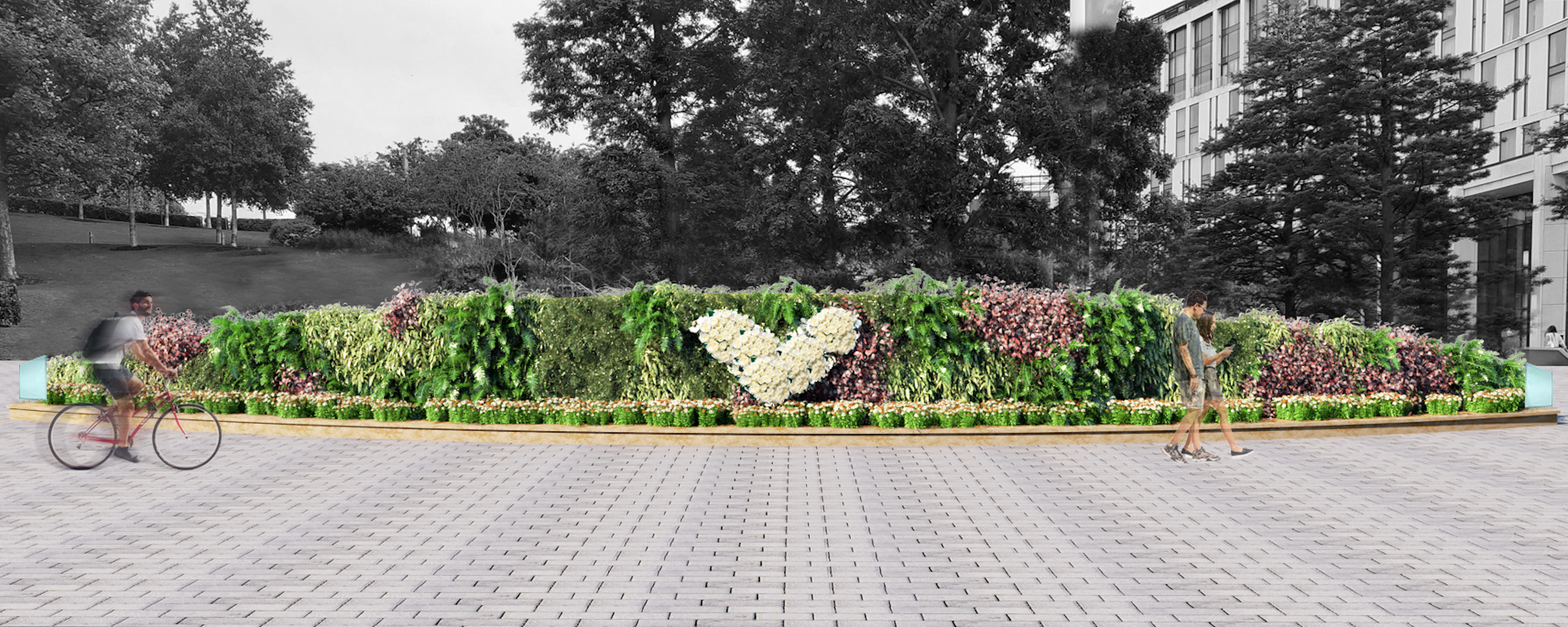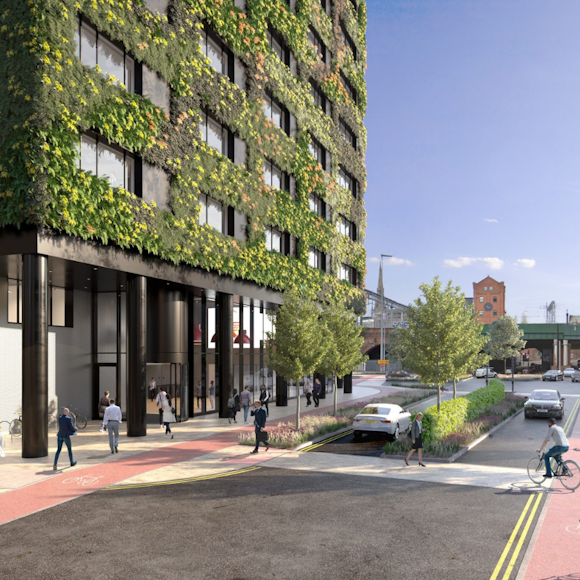From carbon sequestration and fire risk, to 'how long will the plants last': here are the top 20 living wall questions planners ask us! If we don’t get to your question here, please give us a call on +44 1243 545818 or email enquiries@ans.global.
Let’s get started:
1. What are the environmental benefits of a living wall?
The environmental benefits of a living wall that uses natural soil are several. Let’s look at air quality and biodiversity:
- Air quality: Plants clean the air through the process of photosynthesis: absorbing carbon dioxide and producing oxygen, whilst soil assists in capture of particulate matter. Using soil also gives us flexibility with plant selection which allows us maximum opportunity to select species that hold air purification properties.
- Biodiversity: The power of soil cannot be overstated. Using a natural substrate means we have greater flexibility in plant selection, allowing for native species, pollinator planting and sources of nectar. Soil also creates a habitat for bees, burrowing insects and encourages natural colonisation. Our organic soil substrate also includes green waste, furthering the sustainability of the project.
2. Will living walls get vandalised?
Living walls (or green walls) are unlikely to get vandalised. Here’s why:
- If the planting is well-established, it is unlikely to be damaged as it is difficult to remove any plants.
- You cannot graffiti on a living wall (easily!)
- The modules are fixed back to the substructure, so are secured in place.
- We’ve worked in several areas where the integration of nature (including living walls) have reduced anti-social behaviour in the area. This has been most noted in Parr Street. Studies have noted 7-8% less crime in areas with access to nature.

3. Do living walls come with any green credentials?
Living walls carry multiple advantages for gaining green credentials, however system choice and design plays a big part in what you can achieve. Natural soil is important for biodiversity and can also help towards BREEAM ratings. The plant palette can be created with the purpose of the project in mind, whether that is for biodiversity net gain, BREEAM or WELL standards.
We have experience with working on projects to aid compliance with Biodiversity Net Gain (BNG), BREEAM, Urban Greening Factor (UGF) and working with a Circular Economy approach.
4. Can living walls be installed on a listed building?
You can’t normally fix a living wall back to a listed building, but you may be able to use a protruding frame.
5. Is it possible to have a free-standing living wall?
It is possible to have a free-standing living wall. Of course, we need to be able to attach the living wall onto something, so a frame would need to be built (for example, a steel frame), then we can attach the living wall to that. The works at The NEC and Liverpool One are good examples of this.
_zzexg.JPG?w=820&q=90&auto=format&fit=crop&crop=edges,focalpoint&fm=png)
6. Can rainwater be used to irrigate a living wall?
Yes, rainwater can be used to irrigate a living wall. We call this rainwater harvesting. However, it is something to be discussed as early as possible in the project, as how the rainwater is collected and fed into the irrigation system needs to be planned out and integrated into designs.
7. Can you grow edible plants in a living wall?
Edible plants can be grown in a living wall, such as strawberry plants and herbs. The living walls at Parr Street, Foundation Park and 2 London Wall Place are good examples of this. Pictured below are strawberries growing on one of the green walls at Foundation Park car park.
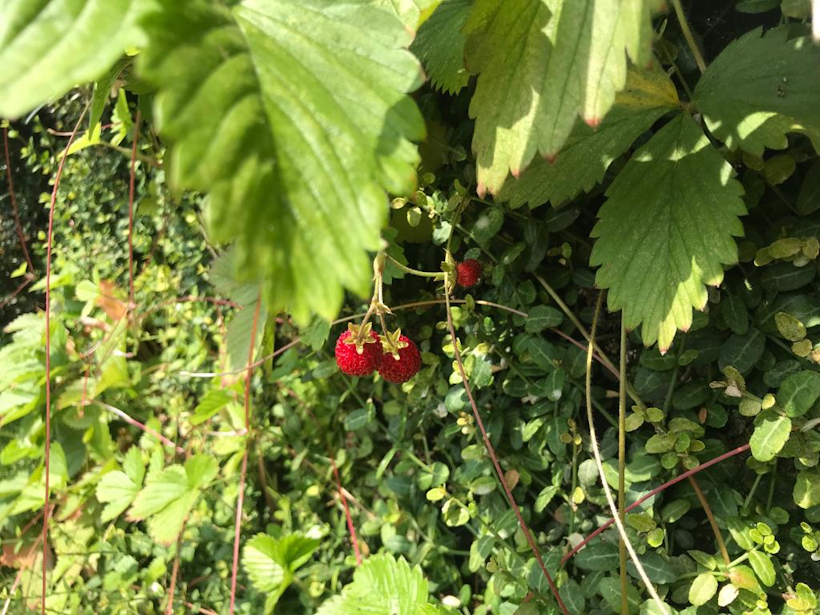
8. Can a living wall be maintained by the local community?
We don’t recommend that a living wall is maintained by the local community, as you cannot ensure the quality and thoroughness that a living wall requires to stay in full health.
9. Who would be responsible for designing a living wall?
Either us (Viritopia) or any other professional consultant on the project would be responsible for designing the living wall.
10. How long will the plants last in a living wall?
The lifespan of plants in a living wall depends on the type used. Typically, we allow 3-5 years for herbaceous plants (plants with flexible, green stems with few to no woody parts), and 5-7 years for shrubs or plants with woodier stems (for example Begonias or Sarcococca Sweet box). Full plant replacement is covered in our maintenance contract.
11. Do living walls help with carbon sequestration?
Living walls have been proven to help with carbon sequestration. In fact, a study by University of Dresden found that just 1sqm of living vegetation can remove 2.3kg of CO2 from the air every year. The combination of the soil and carefully selected plants capture and filter airborne pollutants.

12. Will living walls reduce the local air temperature?
Living walls won’t reduce the general local air temperature, but will cool the immediate surroundings. McPherson (1994) noted how tests have shown temperature differences of up to 17°C between hard and vegetated surfaces in the same location. A study in Iran showed how a modular living wall system reduced the ambient air temperature by up to 8.7°C. This is due to the evapotranspiration of the soil and plants, where the water droplets released cool the air.
13. Where does the water have to drain into from a living wall?
The water from a green wall will need to be able to drain into a gutter, which is connected to a normal stormwater run-off system. It can also be connected to an eco-drain.
14. Can a living wall be fixed back to any façade?
A living wall can be fixed back to almost any façade. With our four different green wall build-up options, we can fix back to:
- A steel frame
- Brick surface
- Concrete surface
- Internal existing substructure
Take a look at our living wall installation guide for build-up drawings.
15. Will a living wall help us achieve biodiversity net gain?
A living wall can indeed help you to achieve biodiversity net gain (BNG). Using soil, and purposefully curating a plant palette that supports local biodiversity will aid net gain. You may find the guides we created with AECOM on using green infrastructure to help achieve BNG useful. These can be downloaded here. They cover how to design living walls (and green roofs) to achieve different BNG targets.
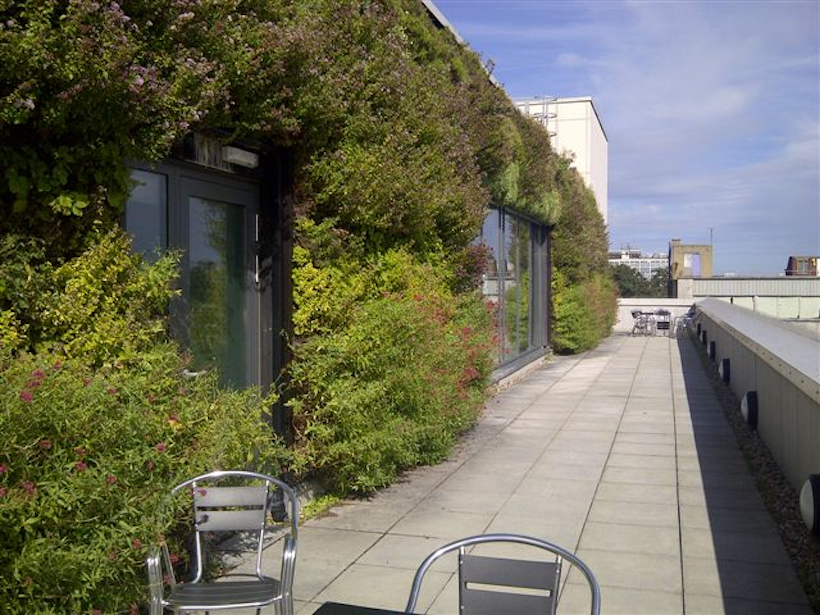
16. What are the fire risks of a living wall?
If a living wall is not maintained, becomes dry and dies, then it will become a fire hazard. This is why we stress the importance of maintenance to ensure the soil has a consistent moisture content and the plants are healthy.
There are a few things that you can do to mitigate the fire risk on a living wall. This includes adapting the build-up, plant selection, irrigation and maintenance schedules. Let’s take a look at what you can do to improve the safety of a living wall in each area:
Build-up:
If you integrate an A2 non-combustible build-up from the inside to the outside of the building, clad the building with a calcium silicate board or another material, then install the living wall on top of that, that improves the fire safety.
The second point is to include fire breaks every 2 metres up the elevation, to contain and stop the spread of fire.
Plant selection:
Avoiding dry grasses and highly oily foliage in your plant palette will improve the fire safety of your finished design. Moving away from the dry oily species and towards evergreen plants that have limited leaf drop is recommended.
Irrigation:
Irrigation is essential to fire safety as a basic rule. With the Viritopia Living Wall System, we design each living wall to have an electronic solenoid at every vertical metre, so each section of planting can be carefully monitored, and irrigation adjusted. This is to ensure the moisture level is kept at around 45%. As an addition to this irrigation system (which is a standard part of every living wall project we do), you could have an independent sprinkler system that comes out of the planting and drenches the façade in the event of a fire.
Maintenance:
The most essential part to mitigating the fire risk of a living wall is ensuring maintenance. It must be a part of the property management scope that the green infrastructure is maintained and should be regarded just as seriously as any other element of the building.
This ensures that the planting and soil is kept in full health, at the right moisture levels with no dry or dead planting (which is more combustible) and the irrigation is serviced regularly.
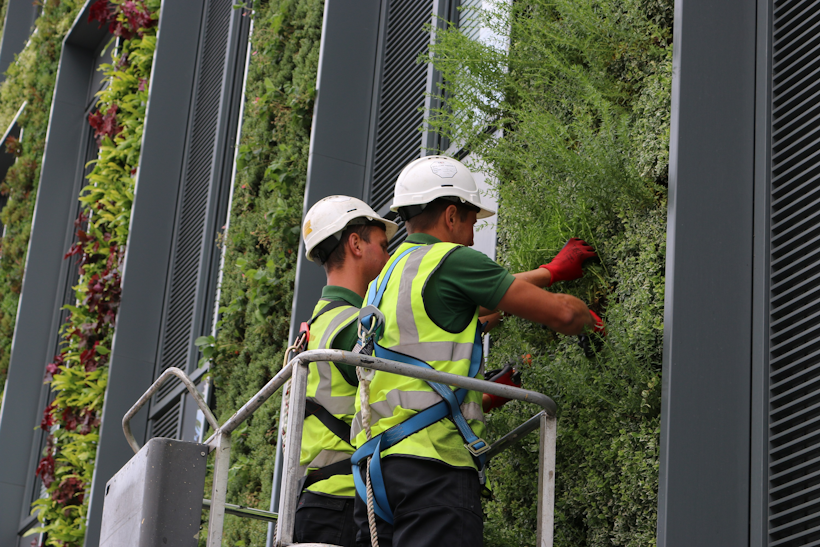
17. Are the plants in a living wall poisonous to the public?
We wouldn’t select plants for a living wall that are poisonous or allergenic to people.
18. What access is required for maintenance of a living wall?
The access requirements for maintenance depend on the living wall and location. For any living wall over 6 metres high, extra equipment is required for the twice-yearly horticultural husbandry visits. This could be a cherry picker, scissor lift, scaffold tower, spider lift or even access by abseil.
19. Who pays for maintenance of a living wall?
Payment for maintenance of a living wall normally comes down to the property owner, but sometimes the cost is passed onto the tenant.
20. What M&E requirements are there and who provides it?
The M&E requirements are as follows:
- Power supply
- Water supply
- Drainage
These are provided by the main contractor or the client. For more details on M&E requirements for a living wall, please get in touch.
Have we answered all your questions about living walls?
We’re here to talk if you have any questions or would like more information on living walls and our process that turns your idea into a reality. Email us at enquiries@ans.global or call +44 1243 545818 to start a conversation.
(If you prefer a form we have one of those too! Click here.)
Other resources you may be interested in:
Blog: The benefits of green walls for urban biodiversity
Flipbook: The 2022 Storybook
